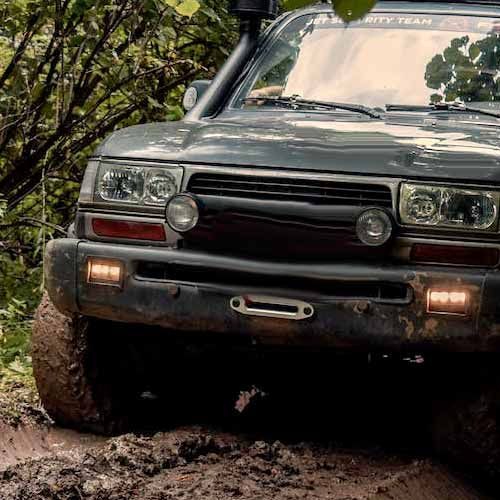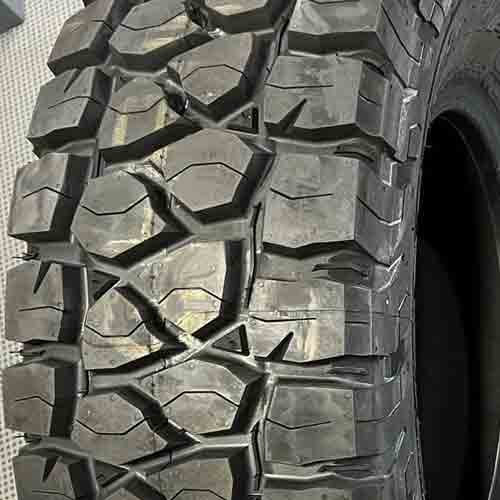While many A/T and R/T tires cater to recreational needs, the BF Goodrich HD-Terrain stands apart, purposefully crafted for commercial applications. Engineered specifically for heavy-duty trucks, this hybrid A/T tire addresses the escalating needs of today’s powerful pickup trucks, work vans, and bigger SUVs that routinely tackle challenging terrains. But is this tire really for you? Let’s find out.

Being a tire engineer, my evaluations tell me that the BF Goodrich HD-Terrain is a decent option when it comes to highway performance, where the tire offers excellent traction, responsive (enough) steering, and stability. Moreover, it also handles hydroplaning in wet scenarios adequately, though wet grip could be improved. In snowy conditions, it’s effective, especially on deeper snow. And off-road, it adeptly manages mud, rocks, and sand, supported by its durable tread design.
Specs of Available Sizes
BF Goodrich HD-Terrain T/A KT comes in total of 31 sizes with following specs.
- Rim sizes: 16 to 22 inches.
- Speed ratings: Q only.
- Load rating: C to F.
- Weight range: 51 to 82 lbs.
- Tread depth range: 18/32″ on all.
- Only branded with M+S, and missing with 3PMSF rating.
A Side Question Here: Should I add this tire in my list of top aggressive all-terrain tires? If so let me know in the comment section below.
Outer Construction
The BFG HD Terrain consist of 4 main ribs.

The two ribs in the middle have interlocking (somewhat) triangular shaped blocks, with a lot of off-set edges and chamfered sides.
They form a web of grooves running every which way, and in them are bold triangular stone ejectors.
Also all these blocks barely have any siping on them, and even those aren’t full depth.
Moving towards shoulders, they are slightly more blocky with less overall off-set edges, though they still have similar siping pattern.
Moreover, these lugs are staggered, and have notches on them (on every other block). And yes, they also join together on sidewalls, make powerful lugs there.
Though these lugs aren’t more aggressive then its other family members, like the KO2.
Inner Construction
Rugged terrain tires should be able to stand the test of harsh environments.
So for the most part, the treads of these tires are intricately designed with halogenated isobutylene rubber enriched with silica, as this composition ensures they resist cuts with utmost efficiency.
Though still, main durability comes from internally.
The BF Goodrich HD-Terrain, for instance, gives you a robust single-layered nylon coating beneath its exterior rubber layer. And if you go deeper, and you’ll find these layers proudly resting upon two formidable steel belts.
And then these belts are strategically positioned above the tire’s powerful three-ply polyester casing, which protects the sidewalls (the weakest part of the tire).
So overall, the tire’s construction, is 3 + 2 + 1, i.e. 3 ply polyester, with 2 steel belts, and a nylon cap ply.
Highway Performance
Tire aggressiveness is often inversely proportional to its performance on regular streets. Thus, rugged terrain, or should I say, hybrid tires continually grapple to strike the perfect balance.
And that’s why the BFG here doesn’t disappoint, as it promises commendable traction, precision in steering response, and unwavering stability, the 3 main on-road performance metrics discussed below.
Steering Response
The BF Goodrich HD-Terrain is a testament to thoughtful design. Its rigid tread paired with its snugly fit shoulders allows to have a responsive nature.
I mean it provides a pretty steering response and handling balance, thanks to its light enough weight and stiffer rubber compound.
Comparing to other R/Ts in the market, the HD Terrain with its lighter weight doesn’t tend to under steer, while it’s harder rubber also keep the lug bending/flexing to a minimum resulting in minimum over steering as well.
So overall, you get a good enough steering feedback, for a hybrid tire I mean.
Dry Gripping
Dry gripping is actually the tire’s ability to brake and accelerate while moving on a straight line. That’s why its also sometimes called directional grip (measured with stopping distances).
And here, the BF Goodrich HD-Terrain does pretty well.
The central ribs of the tire, elongated and flanked by biters, promise impeccable directional stability. Moreover, when it’s time to hit the brakes, the lateral grooves spring into action, ensuring a halt as efficient as the renowned Wildpeak RT.
Noise
The BF Goodrich HD-Terrain doesn’t particularly stand out when it comes to noise suppression. Though its performance in this aspect is somewhat neutral, neither particularly quiet nor excessively noisy.
But to offer a comparison, based on my personal experience, the noise level of this tire is on par with that of the KM2.
Basically noise gets generated with air particles coming in (mostly through shoulder voids), and hitting around the tread walls. And the BFG HD, with such wide shoulder grooves isn’t able to provide with a quite enough ride overall.
Though its still not too bad as its design introduces variable pitches that can effectively reduce noise levels, (meaning, different tones are generated as air hits around at different locations, and they try to cancel out each other).
Wet Performance:
The tire’s behavior on wet surfaces can be broadly categorized into two aspects: wet traction and hydroplaning. Let’s talk about them both one after another.
Wet Traction
The BF Goodrich HD-Terrain gives you an all-weather rubber formula, enriched with a balanced mix of silica in its next-generation tread.
This blend grants the tire a commendable elasticity, enabling the sipes to expand and contract fluidly, and this dynamic allows the tire to effectively absorb and dispel water.
(That’s how sipes work, BTW, they literally suck up the water particles in their slits).
Nonetheless, there’s still room for improvement in terms of wet grip, as the limited number of sipes on its tread can lead to occasional slippage.
Additionally, the missing interlocking design of sipes also don’t fare too well during braking and handling, often becoming inflexible and failing to shed water efficiently. So make sure to ensure your traction control is engaged when navigating wet conditions with this tire.
Hydroplaning:
Hydroplaning is the phenomenon where a tire loses contact with the road and glides on water, and it is a pivotal aspect to consider in wet conditions. It basically happens when a layer of water comes in between the ground and the tread.
To counteract this, tires often feature grooves that channel water away, and some aggressive tires like the BF Goodrich HD-Terrain are equipped with broad, interconnected grooves, facilitating a pretty swift water drainage.
That’s why this is not the issue with this tire.
Snow Performance
While the BF Goodrich HD-Terrain lacks the 3-peak mountain snowflake certification, it shouldn’t be hastily dismissed in snowy conditions.
Basically the 3 peak rating primarily focuses on snow acceleration on roads, and it doesn’t tell you about the handling abilities of the tire in other terrains.
And so while the BFG might not do so well on packed up snowy roads, it still offers commendable traction on deeper snow.
Its wider grooves trap significant amounts of snow, further compacted by the tire’s substantial weight. And this facilitates effective snow-to-snow contact, enhancing friction and consequently, traction.
Snow to snow contact is better compared to snow to rubber contact, as snow particles stick better on one another.
Off-Road Traction
Off road, I subjected the tire to various challenging terrains. Find them below.
Mud
When venturing into muddy terrains, the BF Goodrich HD-Terrain competes neck and neck with many other RT tire variants, including the premium ones.
On paper, the tire showcases impressive traction values, where its design offers significant tread voids running in all directions, throwing mud effortlessly out of its path.
Moreover, its sharp, offset edges are crafted in a way, so that they could dissect mud particles, augmenting overall evacuation further.
Though I’d like to mention that while its staggered shoulders provide satisfactory paddling, the tire would still benefit from additional rubber on its sidewalls.
I mean, the tire’s sidewalls aren’t that aggressive, and when confronted with particularly challenging, deep mud scenarios, the tire struggles a bit, compared to other tires in the category, I mean.
Rocks
Navigating rocky terrains with the BF Goodrich HD-Terrain is a relatively complaint-free experience, as this bad boy strikes a harmonious balance between durability and the biting edges, the two key components, vital for optimal rock climbing.
The tire’s expansive grooves, running at multiple angles, grab the rocky surface in all directions, while its tough 3 ply sidewalls allow for a confidence inspiring mobility.
Sand
Navigating sandy landscapes with the BF Goodrich HD-Terrain proves to be a satisfactory experience as well.
You see on sand, you need footprint, and you need a lighter design, and this tire gives you both.
Despite giving you 3 ply sidewalls, the tire only weighs up to 80 pounds, which is pretty light, comparing other tires, I mean, (like the Toyo RT for example goes up to 100 lbs).
And although the tire could improve its sidewalls, they still do okay with lowered air pressure, enhancing tire’s rubber to sand contact, and resulting in good enough sand traction.
Tread Wear
When stacked against other famous competitors in its category, the BF Goodrich HD-Terrain exhibits slightly above-average tread wear.
So why is that?
Well, first off, the tire does not weight too much, and because of this it exerts less pressure on its lugs, resulting in a lowered friction against the road, and tread burning.
Moreover, the tire also features a tread compound which is relatively stiffer, so it takes more time to wear down to 2/32″ replacement level tread depth.
Fuel Consumption
Fuel consumption is influenced by multiple factors, with tread design and tire weight playing pivotal roles, as they both significantly affect rolling resistance, which is of course a direct measure of fuel efficiency.
And given these considerations, the BF Goodrich HD-Terrain emerges as one of the more fuel-efficient options in the hybrid tire category. It provides not only a consistent rubber compound but also offers reinforced foundations, and a rigid rubber composition.
Additionally, the tire also weigh less relatively, adding to the overall ride stability and reducing rolling resistance.
Take Home Points
So overall, the BF Goodrich HD-Terrain tire showcases an impressive fusion of innovative design and high-quality materials, making it a decent contender in the hybrid tire category.
The tire is equipped to navigate a range of terrains from rock and mud to sand and snow, where it delivers commendable performance.
And yes, its intricate tread design ensures effective resistance against wear and tear, and its fuel efficiency further adds to its appeal.
However, while it stands out in numerous aspects, there are areas where it could use refinement, especially when it comes to on-road traction (in wet conditions, predominately).
In the end, leave with this; for those seeking a reliable, versatile, and efficient tire that can offer decent commercial traction, the BF Goodrich HD-Terrain proves to be a worthy consideration.
Thank you for a good overall unbiased review, which so far has been hard to find for this relatively new tire model.
You wrote an interesting side by side comparison of this and the BFG All Terrain. What I would find very helpful would be a comparison with the Mud Terrain. I have been using the MT for years and have been very satisfied. Unfortunately, they have stopped making it in the 235/85R 16 size I need, so I’m considering the HD. I’ve been looking for information on how performance will differ, especially off road. Any comparisons of mud, sand and rock performance, plus resistance to tread and sidewall damage would be very useful.
Thank you,
Tom
Hmm. Well the thing is KM3 is better with loose stuff, so its going to do better in sandy and muddy terrains, whereas the HD Terrain is slightly better for rocky terrains.
And yes HD also provides slightly tougher sides.